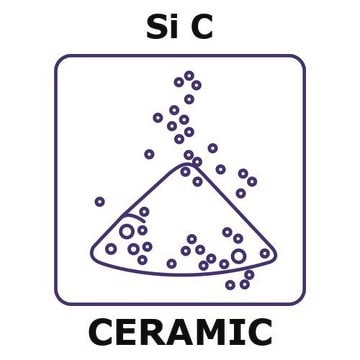594911
Silicon carbide
nanopowder, <100 nm particle size
Synonyme(s) :
Carbon silicide, Carborundum, Methanidylidynesilanylium, Silicon monocarbide
About This Item
Produits recommandés
Forme
nanopowder
Superficie
70-90 m2/g
Taille des particules
<100 nm
Pf
2700 °C (lit.)
Densité
3.22 g/mL at 25 °C (lit.)
Masse volumique apparente
0.069 g/cm3
Chaîne SMILES
[C-]#[Si+]
InChI
1S/CSi/c1-2
Clé InChI
HBMJWWWQQXIZIP-UHFFFAOYSA-N
Vous recherchez des produits similaires ? Visite Guide de comparaison des produits
Catégories apparentées
Description générale
Application
- Overview of silicon carbide power devices: This document provides a comprehensive review of the characteristics and applications of silicon carbide (SiC) in power devices, discussing its advantages over traditional silicon devices in handling high voltages and efficiencies (Choi, 2016).
Forme physique
Code de la classe de stockage
11 - Combustible Solids
Classe de danger pour l'eau (WGK)
nwg
Point d'éclair (°F)
Not applicable
Point d'éclair (°C)
Not applicable
Équipement de protection individuelle
dust mask type N95 (US), Eyeshields, Gloves
Certificats d'analyse (COA)
Recherchez un Certificats d'analyse (COA) en saisissant le numéro de lot du produit. Les numéros de lot figurent sur l'étiquette du produit après les mots "Lot" ou "Batch".
Déjà en possession de ce produit ?
Retrouvez la documentation relative aux produits que vous avez récemment achetés dans la Bibliothèque de documents.
Les clients ont également consulté
Articles
Composite materials with micron scale reinforcements offer tailored properties for various applications.
Silica's versatility spans various industries, including biomedical applications.
Three approaches generate white light, including LED-based down-conversion for broader applications.
Notre équipe de scientifiques dispose d'une expérience dans tous les secteurs de la recherche, notamment en sciences de la vie, science des matériaux, synthèse chimique, chromatographie, analyse et dans de nombreux autres domaines..
Contacter notre Service technique



